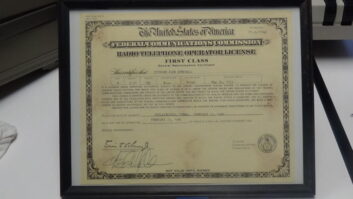There have been numerous comments filed with the Federal Communications Committee regarding improvements to the AM radio service. There are many and often opposing points of view; however some of them could actually be harmonized.
There are Class D stations that would like full-time operation at a reasonable power level. A number of these have had listeners file comments on their behalf supporting extended operation as well. The usual reason involves the broadcast of sports and local political events along with various weather alerts. On its face, that would sound like a compelling reason to expand the service of these stations, but in reality only some stations have the resources (or even the desire) to provide such programming. Other stations will just continue with satellite or brokered programming.
Regardless of intent, these stations need to be considered for a remedy, but not at the expense of other broadcasters.

How can AM radio get its groove back?
iStockphoto/RoBeDeRo
BACKGROUND
Before we go further, let’s look at the history of Class D stations.
The initial stations built in the 1940s and early ’50s were usually on regional channels. Quite often, they were built to either avoid building a DA or because reasonable land was unavailable in a location that would allow the station to provide coverage of their market and protection of co-channel stations.
Initially many of these stations had decent pre-sunrise authorizations so they could sign on at 6 a.m. all year, obviously a better situation than what now exists.
Later, many of those stations added FM service, initially as a simulcast of the AM. Still later, as FM became dominant, many of those FMs were sold off separately and moved closer to more profitable markets, thus orphaning the AM. Some of those orphaned AMs ultimately were taken dark only to be resurrected by a new owner, often at a fire-sale price.
Certain stations in this group have been very vocal about expanding service without understanding that their plight has nothing to do with whatever happens to the Class A stations. They protect the groundwave of co-channel Class B stations, which in some cases have their main DA lobe pointed almost directly at them.
Skywave is just a part of propagation that can’t be revoked and it would be confiscatory to merely operate during darkness and therefore further eroding the groundwave coverage of co-channel stations that can already be greater than 5 mV/m at night. We cannot repeal physics, nor should we take from the population of one or more markets of 200,000 to 300,000 folk just to serve 1,000 or 2,000 people elsewhere.
Looking at a few of these cases, some stations in this group could probably run about 25 kW DA-1 day and night. The problem is that the market is too small to support the construction of such a facility. Two solutions are possible: an FM translator (more on that later), or flash cutting the existing facility to the expanded band. As it appears that more and more translators are going to be quite expensive, the latter solution might be more practical.
The second kind of Class D stations came on air beginning in the late ’50s and early ’60s. Many were on what was then Class 1B “semi” clear channels. Often they were located within the 0.5 millivolt skywave contour of the 1B station and therefore had no chance of getting a micro night power when it became possible much later. In addition to the possibility of buying a translator, they should be first in line to cut over to an expanded-band channel.
Any station operating above 800 kHz would have an acceptable existing facility to cut over. Below 800 kHz — a proposal that the commission to date has brushed aside — stations could operate on 530 kHz. There is a grey zone between 800 and 850 where stations could move either way. Those are practical technical limits and not something to be codified. Ex-band stations would operate with 1,000 watts and stations on 530 with 250 watts EIRP day, 250 watts night and could be spaced about 200 miles apart. The frequency 530 kHz is included in NARBA and in commercial use in neighboring countries, so there is no legal obstacle to its use.
The third kind of Class D station include those that at some point chose to eliminate night facilities for economic reasons or to skirt FCC coverage requirements at the time. Many could provide their own relief by restoring their previously authorized night facilities should they find it economically viable.
Class C stations have enjoyed full-time operation for many decades; however, the Class C channels have always been notorious for high levels of nighttime interference. This is a preview of what the entire band will become if the commission adopts some of current proposals.
Some licensees of these facilities feel they should get a power increase, while others point out an increase will just raise the mutual interference levels. There are also international implications for at least some stations.
Some of the problems of concern to Class B stations have been addressed in the first report and order, while others can be addressed over time as hopefully the band clears somewhat.
A threat to Class B stations is the proposal to reduce protection to 2 mV/m. Most Class B stations have had viable daytime operations for a long time, and some former Class III stations on regional channels have long ago boosted at least daytime power to 50 kW. The problem is nighttime operation when stations already have higher night limits. NIFs above 5 mV/m is already pretty common. The solution to nighttime coverage improvement requires fewer stations on air in many cases.
CLASS WARFARE
The Class A controversy is over 85 years old and has been a form of class warfare the entire time: the big guy vs. the small-town family business.
What has changed over that time is that, when AM radio was the only mass electronic media, it was necessary to have a fair distribution of resources. Since that time numerous other means of reaching the public have evolved, and it is now more practical to think in terms of better leveraging the ability of medium waves to cover wide areas efficiently.
A number of commenters suggested that the daytime power of Class A stations be allowed at the internationally agreed limit of 100 kW. That is at least a small step in combatting rising noise levels. Eventually at some future international conference, that 100 kW limit might be removed. Many things have changed since the limit was put in place in the ’80s.
There has obviously been vigorous discussion over skywave protection for Class A stations. In general, the discussion splits into three camps: those who wish to maintain the status quo; those who have offered hard pragmatic technical data supporting reasons why it should not be protected; and those who don’t fully understand the issues involved and have a misdirected self-interest.
Another factor involving skywave is that it still exists.
The station that receives the skywave interference will have extremely high NIFs, making their service area extremely small, and depending on distance, have well below Class B minimum power. In other words, no improvement to AM, only more interference. An interesting aside to the discussion is that just as some Class D stations justify extended coverage in supporting local school sporting events, a number of major professional sports teams have filed in support of protecting Class A skywave coverage as those teams have numerous fans that rely on that coverage.
The Class A discussion has often been linked to the noise floor. The SBE filed well-crafted but stern comments regarding the FCC’s inaction in enforcing existing Part 15 and 18 regulations. Many comments filed state, quite factually, that the noise floor is universally impairing AM coverage. In reality, while it may be bad in many places, it is not so everywhere, especially in sparsely populated areas where secondary and skywave coverage may be the only available signals.
The SBE comments, if actually heeded by the commission, have the potential to create a lot of blowback from the parties affected by enforcement and may be better addressed by a directive from Congress.
The FM translator issue, though partially settled, still has drawn numerous comments. There are those who believe putting a signal on FM is not AM revitalization and have opposed the concept from the beginning of the proceeding. More recently, some commenters have pointed out that since translators are unprotected, they can potentially be risky. There have been suggestions that stations that license translators that provide satisfactory coverage compared to the AM be given protection in exchange for the surrender of the AM license. They argue that that would provide a greater degree of AM improvement.
Broadcasting is a business like any other, and the business people involved have the right to protect and, where possible, grow their business. Small businesses would be given the equivalent of a land grant in the form of being able to move to a new frequency while medium and large businesses should not be subject to the equivalent of confiscation. Some of those businesses will either fail or find a more effective business model, while others will want to expand. Under our system, all the above should be possible.
The author is chief technical officer for design engineering company Engineaux.
Comment to[email protected].












